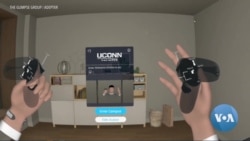ໃນຂະນະທີ່ໂຣກລະບາດສືບຕໍ່ລົບກວນຂະແໜງການສຶກສາຢູ່ນີ້, ຄູອາຈານບາງຄົນໄດ້ຫັນໄປໃຊ້ວິທີທີ່ເປັນທາງເລືອກແບບອື່ນ ເພື່ອໃຫ້ນັກສຶກສາ ມີຄວາມສົນໃຈໃນການຮຽນ. ຢູ່ທີ່ມະຫາວິທະຍາໄລຄອນເນັກຕິກັດນັ້ນ, Tina Trinh, ນັກຂ່າວວີໂອເອໄດ້ໄປຢ້ຽມຢາມຫ້ອງຮຽນຫ້ອງນຶ່ງທີ່ສອນໃນຫ້ອງຮຽນແບບເໝືອນຈິງເປັນບາງສ່ວນ ຊຶ່ງບົວສະຫວັນ ຈະນຳລາຍລະອຽດ ມາສະເໜີທ່ານໃນອັນດັບຕໍ່ໄປ.
ເມື່ອທ້າວຈະເນດູ ອູນຄວາກ (Chinedu Nkwok) ຕັດສິນໃຈລົງທະບຽນຮຽນ ໃນຫ້ອງສອນວິທີເຮັດທຸລະກິດ ທີ່ມະຫາວິທະຍາໄລຄອນເນັກຕິກັດນັ້ນ, ລາວຕ້ອງຮຽນຮູ້ວິທີຍ່າງ. . . ໂດຍໃຊ້ເຄື່ອງຄວບຄຸມຢູ່ໃນຫ້ອງຮຽນແບບເໝືອນຈິງ.
ທ້າວອູນຄວາກ (Chinedu Nkwo), ນັກສຶກສາມະຫາວິທະຍາໄລ ຄອນເນັກຕິກັດເລົ່າສູ່ຟັງວ່າ: "ແລະມັນໃຊ້ເວລາຈັກໜ່ອຍຈຶ່ງຈະຮູ້ໃຊ້ມັນເຊັ່ນວ່າ 'ໂອ້, ຖ້າຂ້ອຍພິກມືແບບນີ້, ຂ້ອຍສາມາດຍ່າງໄປທົ່ວຫ້ອງໄດ້' ຫຼື ເຊັ່ນວ່າຂ້ອຍສາມາດຍ່າງໄປໄດ້ກ້າວນຶ່ງ."
ການຮຽນໜັງສືຂອງທ້າວອູນຄວາກ (Nkwo) ໄດ້ຮຽນຢູ່ໃນຫ້ອງຮຽນທີ່ເໝືອນຈິງຫລື VR ເປັນເວລາອັນສັ້ນໆ ໂດຍໃຊ້ເຄື່ອງຟັງຫູໂອຄູລັສ (Oculus).
ອາຈານສອນໃນຫ້ອງຮຽນ, ທ່ານນາງທາຣາ ວາທຣັສ (Tara Watrous) ເວົ້າວ່າແນວຄວາມຄິດໃນການໃຊ້ VR ແມ່ນມີຂຶ້ນ ໃນໄລຍະທີ່ມີໂຣກລະບາດ, ຍ້ອນວ່າທ່ານນາງແລະເພື່ອນຮ່ວມງານຂອງນາງປະເຊີນກັບສິ່ງທ້າທາຍໃນການສອນທາງອອນໄລນ໌.
ທ່ານນາງວາທຣັສ (Watrous), ອາຈານສອນທີ່ມະຫາວິທະຍາໄລຄອນເນັກຕິກັດກ່າວວ່າ: “ມັນເປັນເລື້ອງງ່າຍຫຼາຍສຳລັບນັກສຶກສາທີ່ຈະມອດຫ້ອງຮຽນ Zoom ໄວ້, ທີ່ ຈະປິດໄມໂຄຣໂຟນຂອງຕົນເອງໄວ້. ແລະສະນັ້ນ ສິ່ງທີ່ພວກເຮົາຮູ້ກໍແມ່ນວ່າ ໃນເວລາທີ່ພວກເຮົາກໍາລັງສອນຢູ່ ມັນເປັນການຍາກຫລາຍແທ້ໆ ທີ່ຈະມີການ ຕິດຕໍ່ກັບນັກຮຽນຂອງພວກເຮົາໄດ້.”
ນາງຄຣິບປາ ມາວາດີ (Kripa Marvadi), ນັກສຶກສາຢູ່ມະຫາວິທະຍາໄລ ຄອນເນັກຕິກັດກ່າວວ່າ: "ຢູ່ໃນຫ້ອງຮຽນ VR, ມັນຂ້ອນຂ້າງວ່າຈະເປັນໄປບໍ່ໄດ້ທີ່ຈະມີແນວເຮັດໃຫ້ ຄວາມສົນໃຈຂອງເຮົາຫັນເຫໄປ ແລະເຊັ່ນວ່າເມື່ອເອົາຊຸດຟັງຫູອອກ, ຈາກ ນັ້ນເຈົ້າກໍອອກຈາກຫ້ອງຮຽນໂລດ."
ຊຸດຟັງຫູສຳລັບ VR ມີຄຸນລັກສະນະບາງຢ່າງທີ່ເອີ້ນວ່າ “ສຽງຕັ້ງໄວ້” — ຜູ້ໃຊ້ ສາມາດໄດ້ຍິນຄົນອື່ນຢູ່ທາງໜ້າ, ຢູ່ທາງຂ້າງ ແລະຢູ່ທາງຫຼັງບໍ່ຕ່າງຫຍັງກັນ ກັບບ່ອນທີ່ເຂົາເຈົ້າຢູ່ໃນຫ້ອງຮຽນ. ມັນເຮັດໃຫ້ມີຄວາມຮູ້ສຶກວ່າໄດ້ຮຽນຢູ່ໃນ ຫ້ອງຮຽນທີ່ແທ້ຈິງເພີ້ມຂຶ້ນ.
ພວກນັກຮຽນເວົ້າວ່າ ຢູ່ໃນຫ້ອງຮຽນແບບເໝືອນຈິງ ເຂົາເຈົ້າມີຄວາມຮູ້ສຶກສົນໃຈ ໃນໄລຍະທີ່ຮຽນຢູ່ນັ້ນເພີ້ມຂຶ້ນ, ແຕ່ມັນກໍບໍ່ເປັນທີ່ຈະແຈ້ງວ່າການ ໃຊ້ເທັກ ໂນໂລຈີນີ້ຊ່ວຍໃນການຮຽນຮູ້ ແລະການຈື່ຈຳເອົາຄວາມຮູ້ນັ້ນໄວ້ໄດ້ແທ້ຫຼືບໍ່. ທ່ານນາງວາທຣັສເວົ້າວ່າມັນເປັນຊ່ວຍໄດ້ແທ້.
ທ່ານນາງວາທຣັສບອກວ່າ:
“ການໄດ້ມີໂອກາດທີ່ແຕກຕ່າງກັນໄປທີ່ນັກສຶກສາບໍ່ສາມາດມີໄດ້ ຖ້າບໍ່ເຮັດແນວນີ້ ເປັນເລື້ອງທີ່ສຳຄັນແທ້ໆ. . . ການທີ່ໄດ້ສໍາຜັດກັບຄວາມຫຼາກຫຼາຍທາງວັດທະນະທໍາ, ກັບພື້ນຖານທີ່ມາ, ບັນຫາຕ່າງໆ. . .”
ແລະຫ້ອງຮຽນທີ່ເໝືອນຈິງສາມາດຊ່ວຍກະຕຸ້ນໃຫ້ເກີດຄວາມຄິດໃຫມ່ຂຶ້ນມາ, ອີງຕາມອາຈານສອນຈຳນວນນຶ່ງ.
ທ່ານເດວິດ ໂນໂບລ (David Noble), ຜູ້ອໍານວຍການສະຖາບັນຜູ້ປະກອບ ການ ແລະນະວັດຕະກໍາ ພີເຕີ ເຈ. ເວີດ (Peter J. Werth) ຢູ່ທີ່ມະຫາວິທະ ຍາໄລຄອນເນັກຕິກັດກ່າວວ່າ:
"ການນໍາໃຊ້ເທັກໂນໂລຈີເຂົ້າໃນຊີວິດຂອງພວກເຂົາ ໃນຊີວິດຕົວຈິງຂອງນັກ ສຶກສາ, ໂດຍສະເພາະແມ່ນເທັກໂນໂລຈີທີ່ກຳລັງອອກມາໃໝ່ ເຮັດໃຫ້ມັນເປັນ ຈິງ ຄືວ່າ ພວກເຂົາສາມາດເລີ້ມວາດພາບເຫັນວິທີແກ້ໄຂບັນຫາໂດຍໃຊ້ເທັກ ໂນໂລຈີນັ້ນ."
ນາງຊາບຣິນາ ຢູວາ (Sabrina Uva), ນັກຮຽນຢູ່ປີສຸດທ້າຍຂອງມະຫາວິ ທະຍາໄລຄອນເນັກຕິກັດເວົ້າວ່າ: "ນີ້ເປັນຄັ້ງທໍາອິດທີ່ຂ້ອຍໄດ້ສໍາຜັດກັບຫ້ອງຮຽນທີ່ເໝືອນຈິງ, ແລະຕອນນີ້ຂ້ອຍ ຢູ່ໃນສະຕູດິໂອເລີ້ມຕົ້ນຂອງສແຕມຝອດ (Stamford) ບ່ອນທີ່ຂ້ອຍກໍາລັງໃຊ້ VR ເຮັດວຽກໃນການຮຽນຂອງຂ້ອຍ. ໃນຕົວຈິງແລ້ວພວກເຮົາກຳລັງເຮັດ ໂຄງການທີ່ເຮັດໃຫ້ເໝາະສົມ-ຄືນອີກ ທີ່ພວກເຮົາກຳລັງຄິດວາດພາບເບິ່ງພື້ນທີ່ ຂາຍຍ່ອຍແບບເໝືອນຈິງຈະເປັນແນວໃດ.”
ສໍາລັບນັກສຶກສາເຫຼົ່ານີ້ແລ້ວ ສິ່ງທີ່ “ເໝືອນຈິງ" ໃນມື້ນີ້ ໃນທີ່ສຸດກໍຈະອາດຈະ ເປັນສ່ວນນຶ່ງຂອງໂລກທີ່ແທ້ຈິງໃນມື້ອື່ນ.
ອ່ານຂ່າວນີ້ເພີ້ມເປັນພາສາອັງກິດ
As the pandemic continues to disrupt academia, some teachers are turning to alternative ways to keep students engaged. At the University of Connecticut, Tina Trinh visited one class held partly in virtual reality.
When Chinedu Nkwo (“chuh-NAY-doo OON-kwah”) decided to enroll in an entrepreneurship class at the University of Connecticut, he had to learn to how to walk . . . using controllers in virtual reality.
Chinedu Nkwo, University of Connecticut Student: “And that took some time to figure out like ‘Oh, if I flick it this way, I can go all across the room’ or I could go like one step.’”
Nkwo’s class met for brief virtual reality sessions using Oculus headsets.
Class instructor Tara Watrous (“TAR-uh WAH-truss”) says the idea to use VR came about during the pandemic, as she and her colleagues faced the challenges of teaching online.
Tara Watrous, University of Connecticut Instructor: “It was very easy for students to turn off their Zoom, to mute their microphones. And so what we were finding was that when we were teaching, it was really difficult to connect with our students.”
Kripa Marvadi is a student at the University of Connecticut: “In the VR space, it’s kind of impossible to like get distracted and just like, take off the headset cause then you're out of class.”
The VR headsets feature something called “positional audio” — users can hear others in front of, besides and behind them, relative to their location in the room. It adds to the feeling of being in a real classroom.
Students say in VR, they’re more engaged, but it’s unclear whether using the technology actually helps with learning and retention. Watrous says it does.
Tara Watrous, University of Connecticut Instructor: “The exposure to different opportunities that students wouldn't be able to have otherwise is a really important piece . . . to be exposed to a wide variety of cultures, backgrounds, problems . . .”
And VR can help spark new ideas, say some educators.
David Noble is the director of the Peter J. Werth Institute for Entrepreneurship and Innovation at the University of Connecticut:
David Noble, University of Connecticut Technology and Innovation Expert: “The use of technology in their, in students’ actual lives, especially emerging technology, makes it real such that they can start to imagine solutions using that technology.”
Sabrina Uva is a senior at the University of Connecticut: “This was the first time I was exposed to virtual reality, and now I’m in the Stamford startup studio where I’m actually using VR in my work. We’re actually doing a re-fit project where we’re visualizing a retail space in virtual reality.”
For these students, what’s “virtual” today could eventually be a part of the real world tomorrow.










